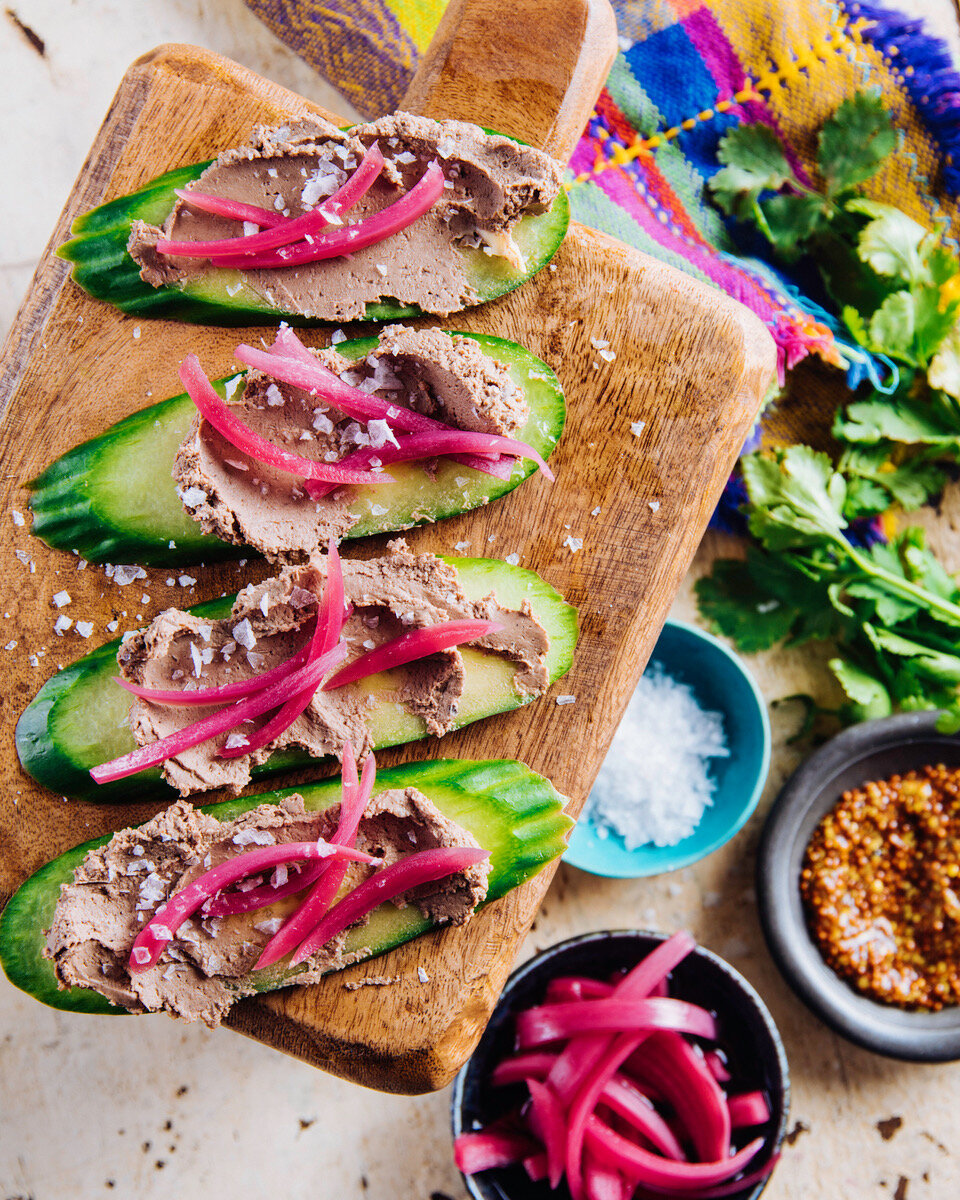The SUPERFOOD you probably are not eating, ORGAN MEAT!
Looking back at my formative years, I think about the many memories (good and bad) that surrounded my family kitchen. Every night we’d come together to cook, eat and talk about our day. Sometimes we’d fight over who got the first taste of marinara, and other times, my dad would fry up some chicken liver and onions, and it would quite-literally clear the room.
Dad would wrangle us back and make us try it, “just once”, he would say. That small practice of giving new and unfamiliar things a chance helped to shape me into the cook and eater I am today. I attribute so many of my foodie obsessions to dad, from creamy pâté to briny raw oysters.
While chicken livers might have been a daring feat for the seven-year-old me, they were actually sought after in earlier times for their flavor profile and nutrient density. It wasn’t too long ago that utilizing the whole animal, from nose to tail, was more the norm. Livers, sweetbreads, and tripe were widely consumed and enjoyed in the old days, and would you believe there was less disease than we have today?
I decided to dig deep into this when in the same week Grass Roots and Dr Jess (if you do not follow her your are missing out), asked me to write about organ meats to help their readers and customers understand the importance. It was a sign we all needed to start adding these to our lives, even though I always make the liver pate (recipe below) during my cyle.
You still see organ meat used in recipes across Europe, Middle Eastern, and Japan but not so much here in America. Because of large-scale farming, the Standard American Diet, and the fast commercialized food movement, we’ve stopped using the whole animal and we’ve lost that old-world connection to our food. Most people just go to the store and buy plastic-wrapped steaks with little to no understanding of where they come from. The American diet has become increasingly reliant on processed foods from factory and commercial farms, widening the gap between us and our food sources.
The good news is that times are changing thanks to the carnivore and paleo movement. Not only are people eating in alignment with our wise ancestors, they are realizing (and talking about) how much better they feel. Heck, I recently had a client text me to say that Whole Foods was sold out of bones and liver!
So why should you start using organ meats in your kitchen to optimize your health and the flavor of your food? Well, “liver is the most nutrient-dense food we can eat. The concentration of minerals, vitamins and mitochondria is so dense even just a bite will carry you through for a week. Plus, you're helping the butcher and the farmer by eating all the parts of the animals.” -- Wise Traditions
As an integrative nutritionist and author working with thousands of clients, I continue to see health issues related to our diet. Specifically the depletion of essential micronutrients, chronic disease, and inflammation are all on the rise. To me, quality organ meat consumption is far better than any multivitamin you can buy. Each organ meat varies with its exact nutritional content but most are high in essential fatty acids, vitamin B12, vitamin A, folate, choline, selenium, iron, and protein.
What exactly is organ meat?
Also referred to as “offal,” organ meat comes from the organs of animals that you can prepare and consume. The most commonly consumed organ meat comes from chicken, lamb, pig, cow, and goat. The most common varieties include the following; tongue, heart, liver, intestine, kidney, brain, thymus (sweetbreads), pancreas, gizzards, stomach and spleen.
Does quality matter?
Yes. Quality matters for a variety of essential reasons. You are what you eat. The same goes for what we eat. You would not want to consume the liver from an animal who has been exposed to toxic substances. Toxins accumulate in the organs, so choosing organic and pastured animals is always going to be better for you.
Here are the things you should be considering when selecting any piece of meat.
What did the animal eat?
Did it roam in the grass?
Was it shot up with antibiotics and hormones to make it fat quicker?
Did it suffer?
Was it under stress?
Was it force-fed GMOs and other toxic food?
Was it exposed to harsh chemicals?
Does it have chronic diseases like obesity and fatty liver disease?
ALL of these factors contribute to the quality of the animal's meat that will either positively or negatively affect us when we eat it. Do you want to get fatter faster too?
So let me ask again, does it matter? Please make sure to always buy the highest-quality liver available. I think about spending money on food like casting a vote. I spend my money on food that supports sustainable and regenerative systems that serve our health and wellness, the environment, and the animal. Like I always say, you can pay the farmer now or the doctor later. The choice is yours…
How to prepare it:
With its uniquely rich flavor, here are my favorite ways to use it. Always rinse or soak with cold water and a splash of vinegar to remove impurities and extract the excess blood, then trim away any connective tissue or tough gristle. There should never be an unpleasant odor so always use your nose to check before cooking. Also, be very careful not to overcook, it can kill both nutrients and texture.
Chop up liver, kidney and heart and add it into your ground muscle meat mixture. With this your options are endless. From ragu to hamburgers, meatball, casseroles or meatloaf, no one will know!
Tongue can also be braised and put into tacos, grilled or chopped and added to soups. Make tongue and heart into a reuben sandwich.
Heart is also great for kababbas, and sauteing.
Any organ meat can be added to rich soups, chile, or beans
Sweetbreads do not have a strong flavor and taste like chicken. You can find them in many upscale restaurants.
Using vinegar, bone broth, onions, wine, butter and heavy cream helps mellow out some of the strongly flavored organ meats.
Pairing cooked organ meats on a nice fermented sourdough bread with pastured butter is always a safe bet.
Nutritional profiles based on organ:
Liver: A, D & B vitamins, k2, copper, zinc, iron
Heart: coQ10, b12, iron, and riboflavin
Spleen: iron, b12, selenium
Sweetbreads (thymus gland): amino acids, and protein
Kidney: omega 3 fatty acids, folate, copper, selenium, zinc
Brain: protein, omega 3, folate , iron, zinc, selenium, B vitamins
Tongue: complete protein, iron, zinc, potassium, choline, and vitamin B-12
Five Reasons Why You Should Eat Organ Meat:
Incredibly dense in protein
Increases energy
Great for skin
Supports immune function
Rich in micronutrients
At this point you might be thinking ew Torie, I don't know if I can do this. First, as my dad says, try it once. I would start by ordering a blend of ground beef and organ meat from a reliable source (see sources below) before you totally give up. If you still can't stomach it (literally) I recommend taking it in a pill form.
Where to buy it:
I have partnered with GRASS ROOTS to give you $30 off $150+ plus free shipping (one use per customer, enter code THEVIDAWELL @ checkout) You can find the blogpost I did with them here.
Supplements:
Ancestral Supplements- use code TVW
NOURISHING ANCESTRAL LIVER PÂTÉ (from my Mexican Keto Cookbook page 87)
SERVES 6 TO 8 • PREPARATION TIME 35 MINUTES
Not only is liver a good-for-you ancestral superfood, but it’s also cheap (because people are afraid to eat them), in an easy to absorb bioavailable form and so delicious. Liver is one of the most nutrient-dense foods in the world. It’s rich in protein, micronutrients, fat-soluble vitamins A, D, E, and K, B12, trace minerals, purines, and antioxidants like CoQ10. It boosts our body’s phosphorus, zinc, iron, riboflavin, and folate. And quality matters, so make sure to always buy the highest-quality liver available.
Ingredients:
1 pound pasture-raised chicken livers
1 stick (8 tablespoons) ghee or grass-fed butter, divided
2 shallots, finely minced
2 garlic cloves, finely minced
2 tablespoons apple cider vinegar or freshly squeezed lime juice
¼ cup water
4 tablespoons coconut cream or heavy cream (if not dairy-free)
2 tablespoons MCT oil, avocado oil or coconut oil
1 teaspoon sea salt, plus more to taste
½ teaspoon freshly ground black pepper
½ teaspoon nutmeg
Method:
1. Prepare the chicken livers by using kitchen shears or a small knife to trim off any discolored parts, excess fat, veins, and connective tissues (the stringy bits). This step ensures a creamy pâté consistency at the end. Rinse the livers, pat them dry with a paper towel and slice thinly.
2. Heat a medium pan over medium-low heat. Use about 1 tablespoon ghee (or butter) to grease the pan. Add the shallots and cook until they have softened but not browned, approximately 3 minutes. Add the garlic for the last minute, making sure not to burn it. Add the vinegar and cook until most of the liquid has evaporated, 3 to 5 minutes. Transfer the shallots, garlic, and pan sauce to a food processor.
3. Grease the pan with 4 tablespoons of ghee so that the livers don’t dry out. Add the water and the livers and sauté just until they are cooked through and no longer pink on the inside. Do not overcook them. Transfer the contents of the pan to the food processor.
4. Pulse the livers with the shallot-garlic mixture, adding remaining 4 tablespoons of ghee one at a time, until all of the ghee has been incorporated and the pâté is very smooth about 5 minutes (scrape the sides down as necessary). Add in the coconut cream, MCT oil, salt, pepper, and nutmeg. Process until well combined; it should be very smooth.
5. Transfer the chicken liver mixture into ramekins or other serving dishes and level the surface using a small spoon or spatula. Cover and chill the pâté for at least 2 hours or overnight so the flavors can set and come together.



